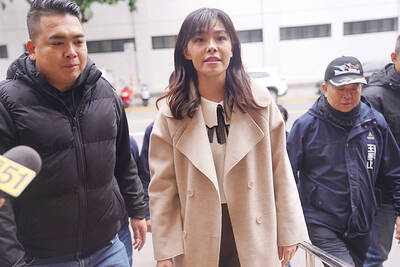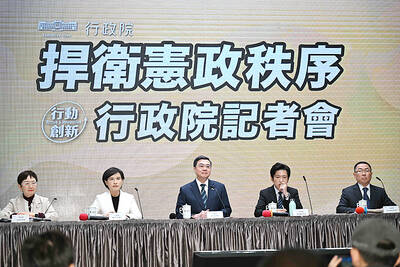President Ma Ying-jeou (馬英九) said yesterday that Taiwan should be more open and relax its rules on investment in China by Taiwanese chipmakers, noting that the US allowed Intel Corp to build a 12-inch factory in Dalian last year.
“I believe that it is a reasonable and necessary policy for our government to open up further,” Ma said as he met Mike Splinter, president and chief executive officer of Applied Materials, a supplier of products and services to the semiconductor industry, at the Presidential Office.
Taiwan Semiconductor Manufacturing Co (TSMC, 台積電) and other chipmakers have been seeking to move more production to China to be closer to customers, but at present they are only allowed to set up 8-inch factories.
Taiwan is “lagging behind” the US, as the government only allows chipmakers to produce 8-inch or smaller wafers in China and to use 0.18-micron or larger processes, Ma said. The government should ease controls as long as the move does not violate the spirit of the Wassenaar Arrangement on Export Control for Conventional Arms and Dual-Use Goods and Technologies, he said.
The 1996 pact aims to ensure that transfers of these items do not contribute to the development or enhancement of military capabilities that undermine regional and international security and stability.
If the US government, which was a key player in the pact, allowed Intel to set up a 12-inch factory, Taiwan should also relax its investment regulations on the semiconductor industry, Ma said.
The Ministry of Economic Affairs (MOEA) held a press conference later yesterday to say it would incorporate Ma’s ideas next month as it relaxs restrictions on technology investment in China, after it completes its plan to remove the 40 percent cap on China-bound investment this month.
“As long as we are able to control our key technologies, we can basically follow international standards,” Minister of Economic Affairs Yiin Chii-ming (尹啟銘) said.
The Wassenaar Arrangement requires the technology during the production stage at Intel’s wafer plant in Dalian to be at least two generations behind the latest technology after it goes into mass production. For example, the US allowed Intel to set up a 12-inch wafer fab using 90 nanometer process technology in Dalian, as the latest technology in the US is 45 nanometer.
After the Dalian wafer fab goes into the mass production stage, both 90 namometer and 65 nanometer process technologies will be allowed to be used in Dalian, as the latest technology will have advanced to 32 nanometer in the US by then.
But even if the restrictions are lifted, Yiin said the possibility that Taiwanese semiconductor firms will invest in 12-inch wafer fabs in China is rather low, as China’s semiconductor industry is not as competitive or as complete as Taiwan’s.
At a separate setting last night, Lin Chen-wei (林成蔚), director of the Democratic Progressive Party’s Department of International Affairs, urged Ma to do his homework and be more cautious when commenting on economic policies.
“Talking through his hat without making a thorough assessment will only worsen the economic downturn and cause more disasters in the stock market,” Lin said.
He said Ma was making an naive decision “based on the simple logic that the US allows chipmakers to invest in China, so Taiwan can too.”
Such a policy would put Taiwan in a very dangerous situation, Lin said.
Additional reporting by CNA and Staff writer

The US government has signed defense cooperation agreements with Japan and the Philippines to boost the deterrence capabilities of countries in the first island chain, a report by the National Security Bureau (NSB) showed. The main countries on the first island chain include the two nations and Taiwan. The bureau is to present the report at a meeting of the legislature’s Foreign Affairs and National Defense Committee tomorrow. The US military has deployed Typhon missile systems to Japan’s Yamaguchi Prefecture and Zambales province in the Philippines during their joint military exercises. It has also installed NMESIS anti-ship systems in Japan’s Okinawa

‘WIN-WIN’: The Philippines, and central and eastern European countries are important potential drone cooperation partners, Minister of Foreign Affairs Lin Chia-lung said Minister of Foreign Affairs Lin Chia-lung (林佳龍) in an interview published yesterday confirmed that there are joint ventures between Taiwan and Poland in the drone industry. Lin made the remark in an exclusive interview with the Chinese-language Liberty Times (the Taipei Times’ sister paper). The government-backed Taiwan Excellence Drone International Business Opportunities Alliance and the Polish Chamber of Unmanned Systems on Wednesday last week signed a memorandum of understanding in Poland to develop a “non-China” supply chain for drones and work together on key technologies. Asked if Taiwan prioritized Poland among central and eastern European countries in drone collaboration, Lin

BACK TO WORK? Prosecutors said they are considering filing an appeal, while the Hsinchu City Government said it has applied for Ann Kao’s reinstatement as mayor The High Court yesterday found suspended Hsinchu mayor Ann Kao (高虹安) not guilty of embezzling assistant fees, reducing her sentence to six months in prison commutable to a fine from seven years and four months. The verdict acquitted Kao of the corruption charge, but found her guilty of causing a public official to commit document forgery. The High Prosecutors’ Office said it is reviewing the ruling and considering whether to file an appeal. The Taipei District Court in July last year sentenced Kao to seven years and four months in prison, along with a four-year deprivation of civil rights, for contravening the Anti-Corruption

NO CONFIDENCE MOTION? The premier said that being toppled by the legislature for defending the Constitution would be a democratic badge of honor for him Premier Cho Jung-tai (卓榮泰) yesterday announced that the Cabinet would not countersign the amendments to the local revenue-sharing law passed by the Legislative Yuan last month. Cho said the decision not to countersign the amendments to the Act Governing the Allocation of Government Revenues and Expenditures (財政收支劃分法) was made in accordance with the Constitution. “The decision aims to safeguard our Constitution,” he said. The Constitution stipulates the president shall, in accordance with law, promulgate laws and issue mandates with the countersignature of the head of the Executive Yuan, or with the countersignatures of both the head of the Executive Yuan and ministers or